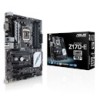Asus Z170-E Z170-E Users manual English - Page 104
CSM Compatibility Support Module, Secure Boot, Boot from PCI-E/PCI Expansion Devices [Legacy only]
 |
View all Asus Z170-E manuals
Add to My Manuals
Save this manual to your list of manuals |
Page 104 highlights
CSM (Compatibility Support Module) This item allows you to configure the CSM (Compatibility Support Module) items to fully support the various VGA, bootable devices and add-on devices for better compatibility. Launch CSM [Enabled] [Auto] The system automatically detects the bootable devices and the addon devices. [Enabled] For better compatibility, enable the CSM to fully support the non-UEFI driver add-on devices or the Windows® UEFI mode. [Disabled] Disable the CSM to fully support the non-UEFI driver add-on devices or the Windows® UEFI mode. The following items appear only when you set the Launch CSM to [Enabled]. Boot Devices Control [UEFI and Legacy OPROM] This item allows you to select the type of devices that you want to boot. Configuration options: [UEFI and Legacy OPROM] [Legacy OPROM only] [UEFI only] Boot from Network Devices [Legacy only] This item allows you to select the type of network devices that you want to launch. Configuration options: [Legacy only] [UEFI driver first] [Ignore] Boot from Storage Devices [Legacy only] This item allows you to select the type of storage devices that you want to launch. Configuration options: [Legacy only] [UEFI driver first] [Ignore] Boot from PCI-E/PCI Expansion Devices [Legacy only] This item allows you to select the type of PCI-E/PCI expansion devices that you want to launch. Configuration options: [Legacy only] [UEFI driver first] Secure Boot This item allows you to configure the Windows® Secure Boot settings and manage its keys to protect the system from unauthorized access and malwares during POST. OS Type [Windows UEFI mode] [Windows UEFI Mode] [Other OS] Key Management This item allows you to select your installed operating system. Execute the Microsoft® Secure Boot check. Only select this option when booting on Windows® UEFI mode or other Microsoft® Secure Boot compliant OS. Get the optimized function when booting on Windows® nonUEFI mode. Microsoft® Secure Boot only supports Windows® UEFI mode. Install Default Secure Boot keys This item allows you to clear all default Secure Boot keys. 2-54 Chapter 2: BIOS Setup















